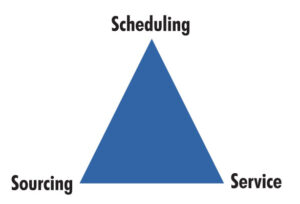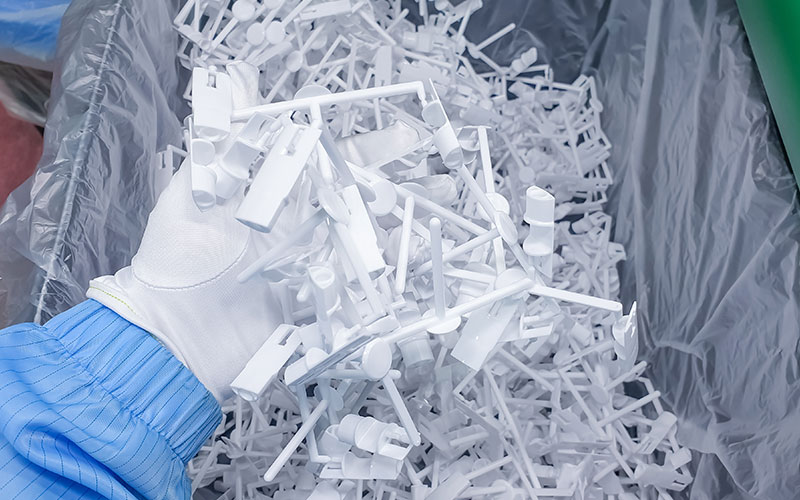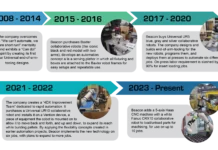by Liz Stevens, contributing writer, Plastics Business
Jedd Smith is the director of quality and operations at EirMed in Menomonie, Wisconsin. EirMed specializes in the design, engineering, manufacturing, assembly and packaging of medical devices. The company serves an array of medical markets, including cardiovascular, dentistry, ear/nose/throat, ophthalmic, orthopedic, spinal medicine and more. Smith spoke recently about applying lean manufacturing solutions to real life at EirMed, specifically about using the gemba walk to identify sources of waste and about techniques for making sources of waste easier to recognize and eliminate.
Gemba
Westerners may associate gemba (or genba) with the quality practices of Japanese automakers like Toyota, but gemba has other connotations in Japan. Though far removed from manufacturing, these other associations illustrate the essence of gemba. To Japanese detectives, gemba is the scene of a crime, and when newscasters in Japan report from gemba, they are reporting directly from the scene. One must be in the thick of things to be in gemba, where the real action is unfolding. And in manufacturing, it’s all happening on the plant floor.
As with the variety of evidence a detective may find at a crime scene or the range of facts a reporter may relay from a news site, taking the gemba walk on a manufacturing plant floor may uncover many instances of waste. To help open one’s eyes and perk up one’s ears to discover waste in manufacturing, Smith’s advice is to know what to anticipate. He said that waste on the plant floor is, by definition, anything that has no added value to it.
Pinpointing waste
In most manufacturing operations, the most obvious source of waste is defects. EirMed has implemented several techniques to address defects, including computerized quality tools like vision systems, instant measurement systems and color spectrometers. “If we have a program where there are multiple components that go into a larger fixed product,” he said, “and there is a Pantone color callout on the print, we cannot rely on our operators’ vision for color matching, because our eyes see different shades and tones.” How, then, can the company get uniform production of a range of parts, molded at different times and on different machines, that will all match when assembly is complete and a batch of products is ready to ship out? “We take the human error element out of it,” said Smith, “by using a spectrometer. By spot checking parts, the spectrometer will show us within three deltas how close we are to our target color.”
EirMed also has implemented eDART systems from RJG – pressure transducers or sensors within mold cavitations. These allow for live monitoring, giving immediate feedback on what is being produced so that problems are discovered as soon as possible. “The sensors will show activity in real time and tell if you are getting short shots or if something is going on with the process itself,” Smith explained.
Smith also relies on other methods, such as looking at past performance and cumulative data about scrap. “We have a scrap sheet log in every work center,” he said, “which details the scrap code per part, per shift. At the end of each shift, the details are entered into our ERP system, so we have the tracking and the statistics on scrap covering what shift, what day and what we were seeing.” The company also implemented a weekly scrap meeting with subject matter experts from each department. “What we are doing is looking at past performance for future runs of that same part,” Smith said. “What problems did we experience last time? What do we anticipate seeing in the future? And what can we do to correct any problems – whether people, process or tool.”
Stay in sync
 In identifying and tackling instances of another source of waste – overproduction – at the plant, Smith pointed to two separate but similar people-centric ideas, one centered around when an order is placed with the company and the other revolving around the company’s suppliers. At the start of a new program, in the order receipt phase, Smith and the team at EirMed review the status of three sets of company players. “We call them the scheduling, sourcing, customer service trident,” he explained. “We look to see whether all of these people are working together in sync. When the order comes through for customer service, does the scheduler also know that this job needs to be scheduled? Do the sourcing people know how much raw material inventory we currently have? Are we good, or do we need to order some more? If we need raw material, what does the lead time look like?” Keeping this trident of players in sync makes for much less waste as new programs are kicked off.
In identifying and tackling instances of another source of waste – overproduction – at the plant, Smith pointed to two separate but similar people-centric ideas, one centered around when an order is placed with the company and the other revolving around the company’s suppliers. At the start of a new program, in the order receipt phase, Smith and the team at EirMed review the status of three sets of company players. “We call them the scheduling, sourcing, customer service trident,” he explained. “We look to see whether all of these people are working together in sync. When the order comes through for customer service, does the scheduler also know that this job needs to be scheduled? Do the sourcing people know how much raw material inventory we currently have? Are we good, or do we need to order some more? If we need raw material, what does the lead time look like?” Keeping this trident of players in sync makes for much less waste as new programs are kicked off.
In relation to suppliers, EirMed strives to always be in sync with its suppliers. Smith calls it practicing strategic sourcing. “We want to know whether the supplier is a company that operates on a just-in-time basis, and whether there is dual sourcing or multiple sourcing of vendors. We need to identify our critical suppliers.”
Smith noted that having ISO certification can be crucial for the company’s jobs, and that doing work for the medical industry brings increased responsibility. Keeping an eye on the financial health of one’s critical suppliers and the risks to the supply chain have become commonplace for some manufacturers. “We look to see if there is a risk of a supplier’s processes being tightened up,” said Smith. He recommended assessing and documenting all of the risks, while continuing to cultivate good relationships with suppliers.
“It is really important to control and maintain that level of relationship with your critical suppliers,” he said. “That is key, especially when the supply chain might be disrupted because of weather or natural disasters.”
Nonutilized labor
For discovering waste in nonutilized labor, Smith checks on EirMed’s profit and loss – every day. “We have a daily P&L,” he said. “Every morning, we look back at yesterday; did we make money that day? If we didn’t, was it due to something that we could control or influence? Did we anticipate the problem that hampered profitability? If we anticipated it, then we should see it in the pipeline and would recognize the return within the day’s performance, and any difference helps us understand that we need to investigate where the gaps lie.”
As another example of decreasing the waste that can stem from nonutilized labor, Smith zeroed in on the regular breaks that operators take and does what is needed to make sure that those operators’ machines are not idle. “We plan coverage for the operators’ regular breaks and lunch periods,” he said. “We rotate the operators to give coverage so that we have as much machine uptime as possible when an operator might leave their station.”
More sources of waste
Transportation is another big area where waste can creep in, especially with operations that are spread out among multiple buildings. “We have two independent buildings at EirMed,” Smith explained. “They are not connected; in fact, they are a fifth of a mile apart. So how do we efficiently get the items that we need from one warehouse location to the other?”
Smith looked at how often various tools are used and how often gaylords were needed. He then reviewed what this meant in terms of daily transportation back and forth between buildings and how that transportation pattern affected the molds. This review pointed to an opportunity. “We only had a cleaning station and an actual tool room in the other building, so we were constantly going back and forth between buildings for tool maintenance,” he said. “We added the ability to perform tool maintenance here in the main building, and now we keep the frequently running molds over here.”
Another common source of waste is inventory waste. Having personnel trained on tracking and managing inventory is big at Eir Med. “We do continuous training on product identification, traceability and disposition,” he said. “We can never have enough training around that. You want to make sure that you know where your products are going and that you can track them and trace them, otherwise you end up with wrong counts.”
Wrong counts lead to ordering raw materials or components that are not actually needed, along with adding in the wait time for deliveries. EirMed uses a box truck dedicated to inventory transportation for rapid movement of inventory back and forth between buildings. “Having two warehouses and an ERP/MRP system that allows us to identify exact locations of products gives EirMed the chance to build ahead for our customers so that we have confirmed, certified product on-hand for immediate delivery if there is an urgent order. With the COVID-19 pandemic, we have seen swings in orders based on the type of product and the customer’s urgent need for the product.”
A final area of waste that Smith assesses is overprocessing, and he described the situation at EirMed when he began working there. “When I first arrived,” he said, “we had a dedicated quality inspector technician who was doing Acceptance Quality Limits (AQLs) on every shipment that went out the door. To me, it didn’t make sense; you want to put the inspection of part quality upfront and save on the scrap costs.”
To Smith, the setup at EirMed was wasting a full-time position by paying somebody to identify the mistakes on the back end rather than catching the problem on the front end that was causing those mistakes. “So, we really focused on putting the part quality inspection upfront. Then, during any finishing services, inspectors only need to look for scrap stemming from the finishing service, as opposed to scrap created by the mold components.”
Be ready to walk
With some of the typical areas of waste identified and some techniques for uncovering and eliminating waste detailed, Smith described his gemba walk at EirMed and the tools he relies upon to uncover waste. “We use the shift production reports, the daily profit and loss, and our throughput metric,” he explained. “We also use real-time monitors and the production board.”
Smith’s real-time monitors cover all of the company’s machines. He quickly can see if the machines are up, and if they are running at the average cycle or behind the average time. If a machine is down, monitors can sense the reason. At EirMed, the real-time monitor information is visible on the plant floor so that everyone can view the activity in every part of the plant. The company’s production board shows all the presses and all the work centers for each shift. The total potential output is calculated and specified at the beginning of every shift. The number of good parts is recorded, along with the number of rejects for each work center.
But monitors can’t replace time in the plant. “Prepare for walking the floor,” he said. “Know what you are looking for and what you should be looking for. Think about what you have seen in the past that may be repeating itself.”
Smith stressed the practice of consistently looking for ways to improve and then monitoring the effectiveness of any changes made. “It is easy to come up with a new idea or to tell people that we decided that there is a different way of doing something,” he said, “but is it going to be effective? Time will tell, and so we look for concrete evidence that our changes were effective.”
Before implementing changes, Smith emphasized the importance of asking questions at all levels and remembering that operators are the experts of the floor. “I tell them that all the time,” he said. “Operators are the ones who know what is going on; they have their fingers on the pulse out there.”
Smith’s final bit of advice? “Follow your instincts when you see a pattern. You walk the floor every day. You see patterns on the floor, whether they are good or bad. If something doesn’t look quite right, dig in and do some more investigation. And always look for ways to improve.”





